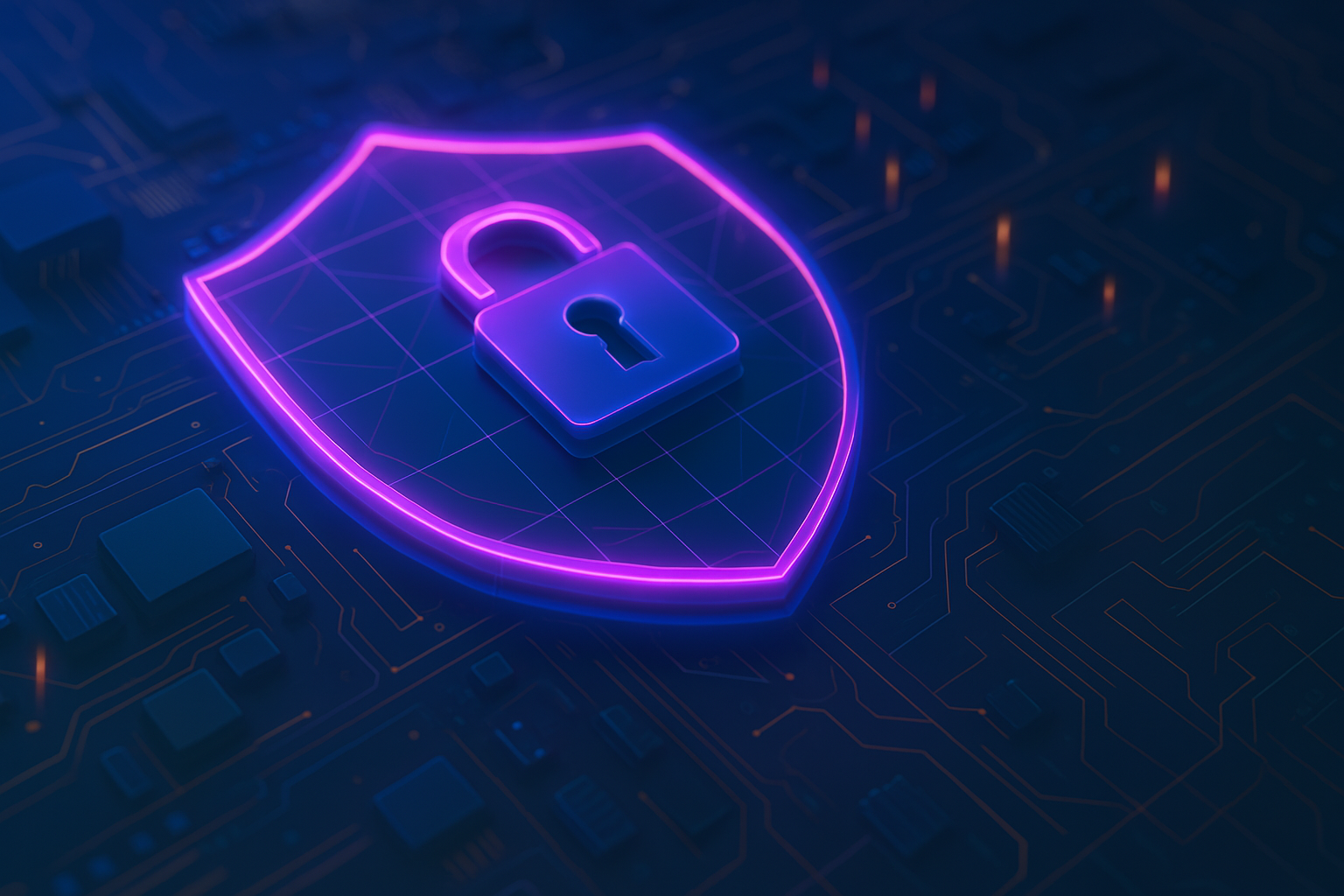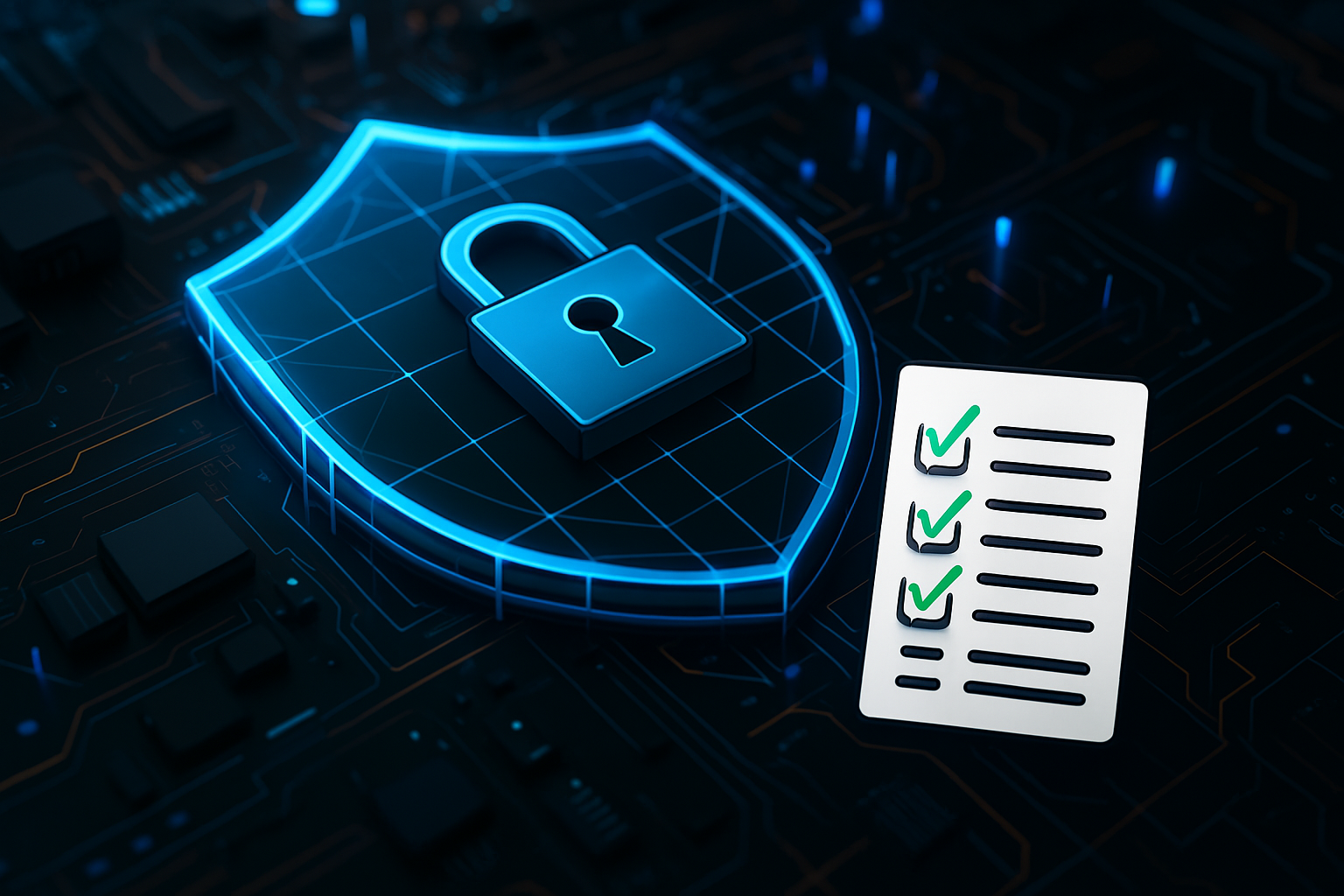Cybersecurity isn’t just a tech concern—it’s a societal necessity in ttoday’s digital world. As we step into 2025, the stakes are higher than ever. With the explosion of remote work, cloud computing, AI technologies, and the Internet of Things (IoT), the attack surface for malicious actors continues to widen. Cybersecurity is no longer optional—it’s foundational for businesses, governments, and individuals.

This blog dives deep into what cybersecurity is, explores why cybersecurity matters in 2025, and outlines the threats, trends, and strategies that define the current landscape. If you’re wondering why cybersecurity is important in this rapidly evolving digital era, this is your ultimate guide.
Let’s start by understanding the fundamentals.
Understanding the Basics — What Is Cybersecurity?
Cybersecurity refers to the practice of protecting computer systems, networks, data, and digital infrastructure likes websites from theft, damage, or unauthorized access. In 2025, it’s about much more than just antivirus software—cybersecurity now includes proactive threat intelligence, zero-trust architecture, cloud security, and behavioral analytics.
According to Cybersecurity Ventures, the global cost of cybercrime is expected to hit $10.5 trillion annually by 2025, up from $3 trillion in 2015. This dramatic increase reinforces why understanding the cybersecurity definition is critical for everyone—from tech teams to C-suite executives.
📌 Key components of cybersecurity include:
- Network Security – Protecting internal networks from intrusions
- Application Security – Keeping software and devices free of threats
- Information Security – Safeguarding data integrity and privacy
- Operational Security – Handling permissions and access controls
- Disaster Recovery & Business Continuity – Responding to breaches efficiently
In simple terms, what is cybersecurity? It’s your digital defense system—a blend of strategies, technologies, and best practices aimed at preventing cyberattacks and minimizing damage when breaches do occur.
But why now? Why is this more important in 2025 than ever before?
Why Cybersecurity Is More Critical Than Ever in 2025
The relevance of cybersecurity in 2025 cannot be overstated. As our lives and economies become increasingly digitized, cybersecurity threats in 2025 are evolving at an unprecedented pace—faster than many organizations can adapt. This is exactly why cybersecurity matters right now more than ever.
📈 Rising Cybercrime Costs
According to IBM’s “Cost of a Data Breach Report 2024”, the average cost of a data breach reached $4.88 million globally, a 15% increase over 3 years. By 2025, this cost is expected to rise further due to inflation, regulatory fines, and business downtime. For businesses, the stakes are high—and ignoring cybersecurity could mean financial ruin.
🏠 Remote Work & Cloud Dependency
The pandemic may have accelerated remote work, but by 2025, it has become the norm. This means employees are accessing company systems from unsecured home networks, personal devices, and various global locations. Cloud adoption, while offering flexibility and scalability, has introduced new cybersecurity challenges in 2025 that require next-gen solutions.
- 85% of organizations have adopted cloud-native technologies as of 2024.
- Misconfigured cloud settings account for 60% of data breaches in cloud environments.
That’s why cybersecurity for businesses needs to be built around distributed workforces and hybrid cloud systems.
⚖️ Stricter Data Privacy Regulations
With laws like the Digital Services Act (EU), CPRA (California), and more anticipated regulations in Asia and Latin America, 2025 marks a turning point for compliance-driven security. Businesses that ignore why cybersecurity matters will find themselves facing legal action, penalties, and reputational harm.
💼 Critical Infrastructure at Risk
Cyberattacks have moved beyond targeting just financial or tech sectors. In 2025, critical infrastructures like healthcare, energy, transportation, and even elections are under threat. These are high-impact sectors where breaches can disrupt society, harm individuals, and even threaten national security.
All of these reasons combine to make cybersecurity in 2025 not just important, but mission-critical. The real question isn’t what is cybersecurity, but whether you’re prepared for what’s coming next.
Top Cybersecurity Threats to Watch in 2025
As technology advances, so do the capabilities of cybercriminals. The cybersecurity threats in 2025 are more complex, persistent, and automated than ever before. Understanding these risks is crucial to grasping why cybersecurity matters in our increasingly digital world.
Let’s break down the most pressing threats you need to watch in 2025:
⚙️ 1. AI-Driven Cyberattacks
Artificial Intelligence is a double-edged sword. While it powers modern cybersecurity tools, hackers are now using AI to automate sophisticated attacks.
- AI-generated phishing emails are nearly indistinguishable from human-written ones.
- Machine learning is being used by threat actors to bypass security protocols.
This makes traditional defenses outdated. Investing in cybersecurity for businesses today means adopting AI-enhanced cybersecurity solutions that can fight fire with fire.
🛑 2. Ransomware on Steroids
Ransomware remains one of the most devastating threats. In 2025, it has evolved into Ransomware-as-a-Service (RaaS), allowing even low-skilled hackers to execute massive attacks. The cybersecurity definition now includes proactive backup strategies and encrypted cloud storage for resilience.
According to Statista, ransomware attacks are expected to occur every 2 seconds by late 2025, up from every 11 seconds in 2021.
☁️ 3. Cloud Security Misconfigurations
As organizations continue shifting to the cloud, cloud misconfigurations remain one of the easiest attack vectors. The importance of cybersecurity in 2025 hinges on secure cloud deployment.
- 79% of companies have experienced a cloud data breach in the last 18 months.
- Most breaches stem from human error, not sophisticated hacks.
That’s why cybersecurity for businesses must include employee training, strict IAM (Identity and Access Management), and automated policy enforcement.
👤 4. Insider Threats
Sometimes the threat comes from within. Disgruntled employees, negligent staff, or third-party vendors can unintentionally open the door to attacks.
- 34% of organizations reported insider attacks in the past year.
- In 2025, with more remote and freelance workers, the risk is amplified.
It’s a key reason why cybersecurity matters—because a solid system isn’t just about external defenses; it’s about monitoring internal activity too.
📡 5. IoT and Smart Device Vulnerabilities
With over 30 billion IoT devices connected globally in 2025, these smart gadgets—from thermostats to medical devices—are easy targets.
- Most IoT devices lack firmware updates or strong encryption.
- A compromised smart device can serve as a backdoor into larger networks.
Understanding what is cybersecurity means grasping that it’s not just about protecting computers anymore—cybersecurity in 2025 covers everything with a chip and a connection.
Cybersecurity Trends Shaping the Future
To effectively protect against the sophisticated cybersecurity threats in 2025, organizations must stay ahead of the curve by embracing new technologies, methodologies, and mindsets. This is not just about defense—it’s about building resilience. Here’s a look at the top cybersecurity trends in 2025 that are defining how we prepare for tomorrow’s attacks.
🤖 1. AI and Machine Learning in Cyber Defense
In 2025, cybersecurity and artificial intelligence are inseparable. AI is now critical in identifying patterns, detecting anomalies, and responding to threats in real time.
- 69% of organizations have already integrated AI-driven tools into their cybersecurity for business frameworks.
- Machine learning enables predictive analytics that can identify attacks before they occur.
This trend is redefining what cybersecurity is—from reactive to proactive.
🔐 2. Zero Trust Architecture Goes Mainstream
Zero Trust Security is no longer optional in 2025—it’s becoming a best practice. Based on the principle of “never trust, always verify,” Zero Trust assumes that no device, user, or application is inherently secure.
- 90% of enterprises are expected to adopt some form of Zero Trust by the end of 2025.
- This model minimizes lateral movement within systems if an attacker breaches one point.
This approach underlines exactly why cybersecurity matters in an era of ever-expanding digital footprints.
🧬 3. Biometric and Behavioral Authentication
Passwords are becoming relics of the past. In 2025, authentication is moving toward biometric verification (like facial recognition, fingerprints) and behavioral analytics (typing speed, mouse movement patterns).
- Biometric data is now used by over 60% of Fortune 500 companies.
- Behavioral authentication offers continuous verification, not just one-time login.
This tech directly supports the evolving cybersecurity definition by focusing on personalized and frictionless security.
A shift is occurring in the mindset of IT leaders. Instead of just preventing attacks, the goal is now cyber resilience—the ability to operate and recover quickly after a breach.
- The World Economic Forum lists cyber resilience as a top priority for national digital strategies in 2025.
- Resilient systems integrate cybersecurity with business continuity and disaster recovery plans.
Understanding why cybersecurity matters in this way ensures companies can weather any storm—digital or otherwise.
🌍 5. Global Collaboration and Threat Intelligence Sharing
The future of cybersecurity in 2025 is also about working together. Governments, tech giants, and cybersecurity firms are increasingly sharing data to stop threats before they spread.
- The Cyber Threat Alliance now includes over 30 global members contributing to a shared intelligence network.
- This cooperation has reduced response times to global cyber events by more than 50%.
Collaboration is shaping what cybersecurity truly means today: a united defense against a shared enemy.
As the landscape shifts, businesses must keep evolving. But how do these trends impact the people behind the screens? That’s where culture comes in.
The Business Case: Why Cybersecurity Matters for Companies
In 2025, businesses can no longer afford to treat cybersecurity as a secondary concern or IT-only issue. It’s now a critical pillar of operational continuity, brand trust, legal compliance, and competitive advantage.
If you’re running a company, the question isn’t just “what is cybersecurity”—it’s how well your company is protected, and what you stand to lose if you’re not.
💸 The Cost of Ignoring Cybersecurity
Let’s start with the numbers.
- The average cost of a data breach for companies is projected to exceed $5 million in 2025, according to IBM.
- 60% of small businesses shut down within 6 months of a cyberattack.
- The global cost of cybercrime will reach $10.5 trillion annually by the end of 2025.
These stats make a compelling case for why cybersecurity for businesses is more than a line item—it’s business survival.
🛡️ Customer Trust and Reputation
A single breach can erode years of customer trust. In a world where consumers are more privacy-conscious than ever, failing to safeguard data isn’t just risky—it’s brand suicide.
- 87% of consumers say they won’t do business with a company if they have concerns about its cybersecurity.
- Data breaches damage customer retention and acquisition, affecting long-term revenue.
That’s a huge part of why cybersecurity matters in 2025: it protects your brand as much as your backend.
📑 Regulatory Pressure and Legal Liability
In 2025, businesses face stricter data protection regulations globally. Compliance isn’t optional—it’s enforced.
Key regulations shaping cybersecurity in 2025:
- EU Digital Services Act
- California Privacy Rights Act (CPRA)
- India’s Data Protection Bill
- China’s Cybersecurity Law
Non-compliance can lead to:
- Fines up to 4% of annual global turnover
- Class action lawsuits from affected users
- Mandatory audits and public disclosure of breaches
The importance of cybersecurity in 2025 lies not just in prevention, but in meeting legal obligations that now span continents.
🧠 Competitive Edge Through Security
Companies that invest in robust cybersecurity gain an edge—both in customer confidence and in attracting strategic partnerships.
- 61% of B2B buyers say cybersecurity certifications influence purchasing decisions.
- Investors also view cyber resilience as a sign of a well-managed, future-ready company.
Understanding what cybersecurity is means seeing it as a growth driver—not just a defensive tool.
Building a Cybersecurity Culture
You can spend millions on software and still suffer a breach if your people are the weakest link. In 2025, with cybersecurity threats more complex than ever, organizations must embed security awareness into their DNA. Creating a culture of cybersecurity means transforming every employee into a security asset.
Here’s why this shift matters — and how to make it happen.
📚 Cybersecurity Awareness Training Is Non-Negotiable
Human error continues to be the root cause of 90% of data breaches, according to a 2024 report by CybSafe. That’s why cybersecurity awareness is a must-have in 2025.
Effective programs should include:
- Recognizing phishing attempts
- Securing personal and professional devices
- Password hygiene and multi-factor authentication
- Safe remote work practices
A strong awareness program helps employees understand what cybersecurity is and their role in maintaining it — especially in a remote-first, cloud-connected workplace.
🛠️ Best Practices for Staff at All Levels
Security should be everyone’s job, not just the IT department’s. Whether you’re in HR, marketing, or sales, cybersecurity in 2025 affects how you handle emails, data, apps, and communication.
Encourage a security-first mindset with best practices like:
- Reporting suspicious behavior or emails immediately
- Using encrypted communication tools
- Locking devices when unattended
- Updating software regularly
This reinforces why cybersecurity matters to the entire organization, not just those in tech roles.
🧑💼 The Role of Leadership in Driving Change
Leadership sets the tone. When executives take cybersecurity seriously—participating in training, asking questions, allocating budget—it filters down through the company culture.
- Boards of directors now rank cybersecurity as one of their top 3 concerns (Gartner, 2025).
- CISOs are increasingly part of executive teams, helping shape company-wide strategy.
This shows that the importance of cybersecurity in 2025 isn’t confined to the server room—it’s a boardroom priority.
🎯 Incentivizing Secure Behavior
Positive reinforcement matters. Recognizing and rewarding secure behavior—like identifying phishing or completing training early—goes a long way toward making cybersecurity awareness a habit.
Think:
- Security leaderboards
- Gamified training modules
- Monthly shoutouts or bonuses
Security becomes part of the company DNA when employees understand why cybersecurity matters, and when it’s encouraged, rewarded, and celebrated.
Final Thoughts: Preparing for a Safer Digital Future
By now, it’s clear that cybersecurity in 2025 is not just about firewalls and passwords. It’s a dynamic, ever-evolving discipline that affects individuals, businesses, governments, and society at large. From AI-driven threats to insider risks and cloud vulnerabilities, cybersecurity threats in 2025 are unlike anything we’ve seen before.


